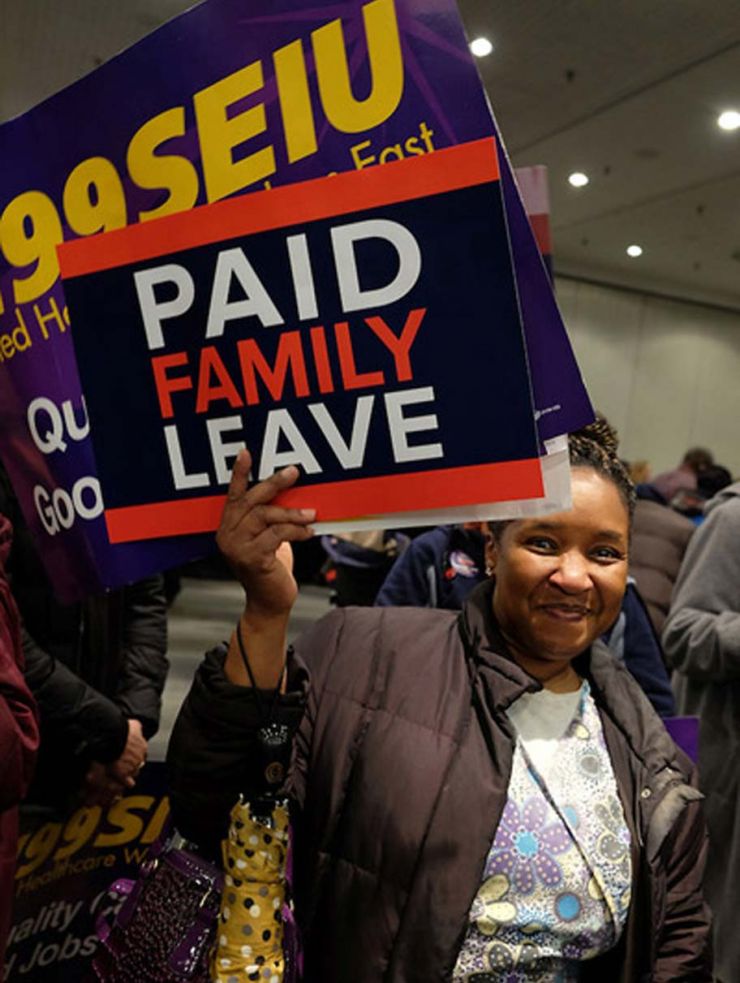New York's Paid Family Leave
June 13, 2016
Ruby Williams has been working as an aide for Premier Home Health Care in New York City for more than a decade. But as a single mother earning $10 an hour, the income she takes home is not enough to allow her to set anything aside to deal with family emergencies.
Before Paid Family Leave (PFL) legislation was passed in New York State in April, most working parents like Ruby could not afford to stop working to care for sick children or family members–when they were most needed at home. But that fact never stopped the crises from reaching the doorstep.
Ruby’s own five children are now grown or nearly grown; like many parents she also has custody of two of her grandchildren, one who is two years old and another who was born just four months ago to her eldest daughter, Dominique. In order to provide a stable home for the children, Ruby moved into Dominique’s apartment in Red Hook, Brooklyn, where she organizes child care in shifts with her other daughter Kimberley, who has a four-year-old of her own.
If PFL had been in place when Ruby’s youngest grandchild was born, she would have had time off to help the child adjust to the family set up in Red Hook. But as it was, Ruby was not in a position to take time off work.
“This new law is going to help a lot of families who right now are having to choose between keeping food on the table and dealing with the stress of a new baby,” said Ruby.
Since the abolition of Aid to Families with Dependent Children in 1996, there are very few lifelines left for low-income families in emergency situations. Ruby has raised her kids alone since they were small. For years she has worked as many hours as she could get to make ends meet on her home health aide wages—with no paid time off to look after any of her children for extended periods when they were sick and certainly no time for her infant children or grandchildren. Under the PFL legislation, which also allows time off to relieve family pressure when someone is called to active military service, the situation for Ruby and millions of others is set to change.
Winning the Fight for $15 in New York in April was such a landmark victory, that it tended to overshadow the other important legislation that brought Paid Family Leave to the state. New York has now joined California, Rhode Island and New Jersey in offering paid time off to care for a sick or disabled relatives or a new child. 1199SEIU was part of a large coalition of labor unions and community groups called Time to Care that put the legislation on the path to victory.
People living in most other states have no such protection and are often forced to take unpaid leave during an extremely stressful period in their lives. Barbara Rodriguez is another 1199SEIU activist who could have really used such help. She has been a home health aide for 15 years, an 1199 delegate for ten years, and currently works for ElderServe, earning $11.25 an hour. Her husband used to work at the Hunts Point meat market in the Bronx, but he was forced to retire with Workman’s Compensation after a work-related hernia. In 2007, his liver started to fail. Barbara did her best to care for him as his condition worsened, but being the main breadwinner, she could not afford to take much time off.
“I had to try to juggle work and doctor’s appointments with my husband. He was so attached to me, he never wanted to go with anyone else,” she recalls. They had married when she was just 14 and had been together for 32 years when he passed away, aged just 56. She would have loved to have been able to spend more time with him as he was slipping away, but without PFL it was simply impossible.
With the introduction of PFL, workers like Barbara and Ruby will be entitled to 12 weeks paid leave per year, to look after new babies and sick or disabled relatives. The program will not come into effect overnight; it will take time for the full effects to be felt by workers. In 2018, workers will be entitled to eight weeks PFL per year. In the following two years the entitlement will go up to 10 weeks a year. It will not be until 2021, that the full 12 weeks can be claimed.
The amount of money received will also climb steadily over time. In 2018, a worker can claim 50% of his or her average weekly wages up to a cap that is equal to 50% of the statewide average weekly wage. In 2015, the New York State Department of Labor reported $1,296.48 to be the average weekly wage. This figure is relatively high, pulled up by some extremely high earners in the state. But it is a cap and does not represent what most people will claim. The percentage workers will be eligible to claim will rise to 67% (approximately 2/3) by 2021.
“This law will benefit a lot of people,” says Barbara, “We all have family members who get sick and we need to be there for them.”


